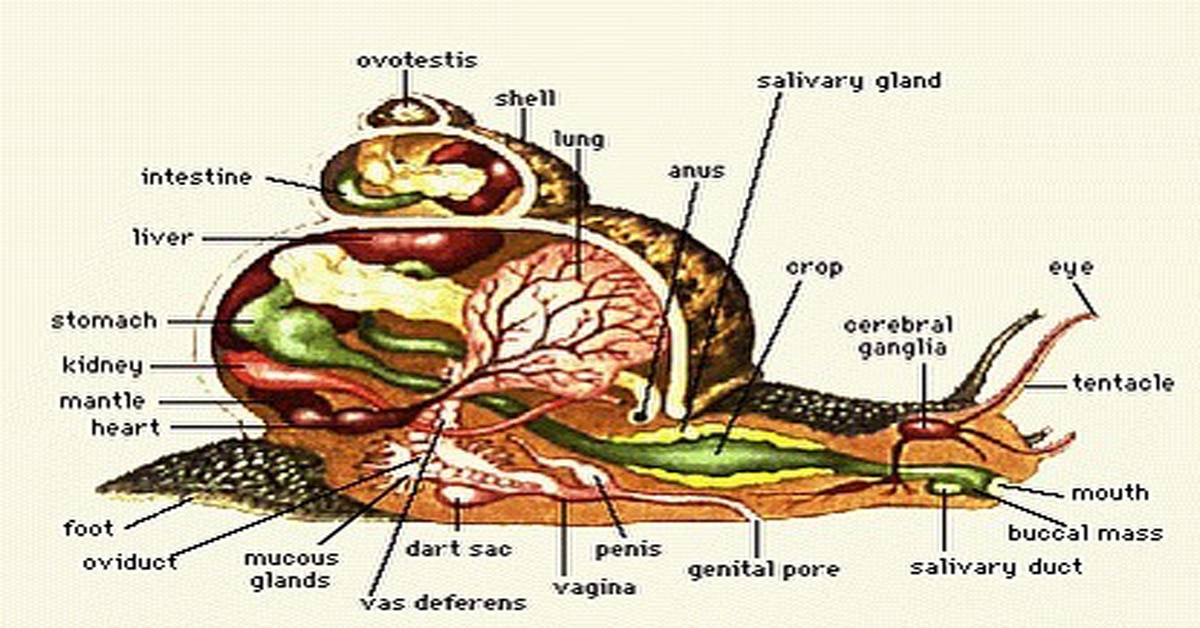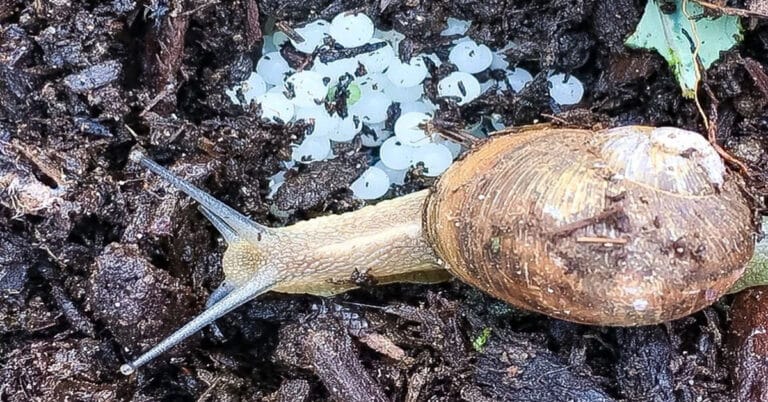Snail Anatomy – All About Internal & External Organs
Many people are shocked to hear that aspects of snail anatomy resemble those of humans. Snails and people are different, after all. Perhaps it is even difficult to imagine an animal that is more unlike us. They move slowly and are tiny, slimy, and delicate. However, humans are fairly resilient and quickly adapt.
If you want to comprehend basic snail anatomy, it’s important to examine it from the outside and inside too. Follow the article if you are interested in finding out and exploring more about the snail anatomy and the different parts of its body.

Basics of Snail Anatomy
Snails are neither insects, nor bugs. They fall into two distinct categories in the animal kingdom. The gastropod class includes snails, whereas the Insecta class includes bugs and other flying creatures. Land, freshwater, and saltwater snails are all included in the class of gastropods. Slugs are also included.
There are between 65,000 and 80,000 distinct species in the class altogether. They are thought to be 500 million years old. Now, let’s look at a different part of snail anatomy and find out more about external and internal snail anatomy.
The Shell
The first thing you notice about the snail is its exterior shell. It is also a primary distinction between a snail and a slug, a member of their immediate family. The shells of the different species vary. They differ in terms of size, color, and shape. However, they are all composed primarily of calcium carbonate and have a spiral shape with several whorls.
Upon birth, snails have tiny, translucent shells. A young snail’s shell will only have one whorl. Its body expands as it ages, as does its shell. They will continue to add more whorls to suit the body of the snail.
The shell’s primary function is to shield the snail’s internal anatomy, which will be covered later. In addition, the snail uses a shell as a defense against predators. The snail will withdraw into its shell whenever it senses danger.
Some of them use shells to protect themselves from unfavorable weather. Snails will enter their shells if the environment is too hot, too cold, or too dry, depending on their habitat.
The Foot
There are no legs on snails. They do, however, possess a feature known as the foot. Essentially, the snail’s foot is its body’s base. The snail moves by making tiny wave-like contractions and expansions using the muscle in its foot. The snail will produce mucus throughout their glide to lessen the resistance.
The extraordinary properties of the mucus enable a snail to move entirely vertically without falling and even crawl over a razor blade without suffering skin damage. When mucus dries, it typically leaves a shiny trail that can be seen. In order to find other snails to mate with, snails might follow those snails.
The Eyes
At the end of their upper tentacles, snails have eyes. What the snails can truly see is still a mystery. However, research and testing have shown that snails can react to light and, to a certain extent, see what is in front of them. The retina, lens, and optic nerve are also present in the snail’s eyes and are part of snail anatomy.
The Brain
Unlike humans and other animals, snails don’t have brains. They have what is known as brain ganglia in science. In the cerebral ganglia, there are four distinct regions. The “operation” of the snail is the duty of each part separately. It’s almost like a simplified brain. However, even with such a primitive brain, the snail has associative learning ability.
Reproductive organs
The majority of land snails are hermaphrodites. It follows that each snail possesses both the feminine organs necessary to produce eggs and the masculine organs necessary to produce sperm.
A snail can technically reproduce alone. Most snails, however, will decide to do it with another member of their species. Snail reproduction is, to put it mildly, a fascinating process. They also perform a dart-shooting routine that is distinctive to them.
Heart
The snail’s heart contains two chambers and is housed in a heart bag. The heart is in charge of maintaining the blood flow between the organs in both the human body and other animals. Additionally, there is another component of the heart bag that aids in the snail’s elimination of indigestible debris.
Basic Land Snail Anatomy
Land snail anatomy is quite dissimilar from that of most other animals. Snails are most commonly recognized for their spiral shell, but this is not all that makes them remarkable. In fact, a snail’s body is a collection of anomalies and startling information that cannot be found in other animals.
While some consider them fascinating, others find them really unsightly. They have distinct anatomy and psychology when you start to examine all of the components of snail anatomy.
External Snail Anatomy
We shall separate the snail’s body into its shell and the soft body that supports it in order to examine its exterior anatomy. The former is a single-piece, solid spiral structure that is borne on the back and is primarily composed of calcium carbonate. Two layers of calcium carbonate crystals make up the ostracum, the middle layer of the shell.
The rest of the body is soft, viscous, and colored darkly with areas of gray or bright. Although it has no legs, it can move because of a “muscular ventral foot”. Muscular contractions in the foot’s wave-like motion help the snail “glide”, while the foot also secretes a slick mucus that lessens friction on the surface it glides over. The “trace” that the moving mollusk leaves behind on the ground is this mucus.
Internal Snail Anatomy
There are no internal divisions in the snail’s body. The mantle protects an organic mass made up of internal organs, which also include the gonads, intestines, heart, and esophagus. Since they are pulmonate creatures, they have lungs that are designed specifically to use the oxygen received from breathing in atmospheric air.
However, they don’t have a brain similar to a dog’s or a human’s. As an alternative, nerve cells congregate in a group of ganglia and generate neurosecretions that bring about required processes like the release of hormones. The nerve fiber bundles that connect ganglia allow for the rapid transmission of signals. Despite having a simple brain, they have associative thinking abilities.
Snails can move their tentacles to improve vision, but their sense of sight is limited to detecting variations in light intensity. to identify if it is day or night. They lack both an ear canal and ears. Therefore, they are essentially deaf. They have great associative skills that help them remember where things in their environment were or where they were.
As we already mentioned, the majority of land snails are hermaphrodites. Although they can self-fertilize, they often mate with one another. The foot and several internal organs are covered and protected by the mantle, which serves as a layer of defense. It may also be discovered that covering the shell provides it with further protection.
Land Snail Sense Organs
Land snails have three primary organ systems to sense their surroundings. Below, we will provide you with detailed information about each of them. Tentacles, statocysts, and nervous systems help snails sense their world and understand where they are or where other objects or things are.
Tentacles
There are two sets of tentacles on the snail’s head: the upper and lower. In most land snails, the upper tentacles have eyes and sensory neurons for smell and taste at their tips. It is unknown how well snails can see, but it is known that they can respond to light and can see where they are going as they move.
The retina, lens, and optic nerves help snails respond to light. The lower tentacles help the snail identify food and avoid potentially harmful locations.
Nervous System
The skin or epidermis of land snails has a variety of nerve cell endings, including bipolar and multipolar cells. These provide snails with the ability to experience touch and pain. When something touches its sensitive body, the snail can detect danger and will retreat behind its shell if needed.
Statocysts
Land snail statocysts, which are part of snail anatomy, are hollow lymphatic fluid-filled balloons surrounded by cells with ciliated interiors. Statoconia, little calcium ions, are floating there. The staphylococci float upward when the snail is upright, hitting the cilia and indicating to the snail that it is upright.
The snail’s foot region is where the statocysts are mostly found. Although they lack a true sense of hearing as humans do, it is thought that snails’ cilia, which resemble tiny hairs, can detect sound vibrations and help them learn more about their surroundings.
Bottom Line
In this article, we discussed snail anatomy and the different parts of its body. Interestingly, humans and snails share many body parts, including the lungs, kidneys, and other organs. This fascinating creature has very good social skills and maybe doesn’t have a brain but has remarkable associative learning abilities.

Nato is a content writer and researcher with a background in psychology who’s eager to explore the wonders of nature. As a travel enthusiast and animal lover, she hopes to inspire others to discover and cherish the beauty and importance of the natural world.







